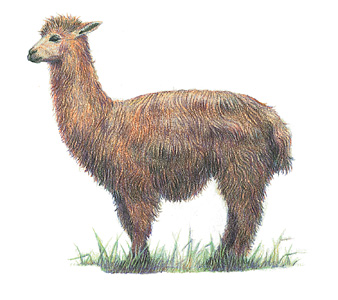Alpaca, << al PAK uh, >> is a grazing animal of South America that is related to the camel. It is raised usually for its fine wool. Sometimes the young, known as crias << KREE ahz >> , are killed for meat. The alpaca lives in mountain regions of Bolivia, Chile, and Peru. It thrives at heights from 12,000 to 16,000 feet (3,660 to 4,880 meters) above sea level. The blood of the alpaca is especially efficient in carrying oxygen, which is less abundant at high elevations.

The alpaca resembles the vicuna, a wild animal of the Andes Mountains. Scientists believe the alpaca is descended from the vicuna. The alpaca has wool that is longer and of lower quality than that of the vicuna. Alpacas are also close relatives of domesticated llamas and wild guanacos, which also live in the Andes.
The alpaca stands a little less than 4 feet (1.2 meters) high at the shoulder. It has a thick coat of black, white, or brown hair that grows from 8 to 24 inches (20 to 61 centimeters) long. This hair is much straighter and finer than sheep’s wool. It provides one of the best fibers known for making warm, soft material. Owners usually shear their alpacas every year. They get as much as 7 pounds (3 kilograms) of wool from some of them.
Bolivia and Peru have become the world’s most important producers of alpaca wool. They export much of the wool to the United States and Europe to be manufactured into cloth. They weave the remainder at home and often make shawls out of it. Indians of Peru raised alpacas, and made the wool into cloth for hundreds of years before Europeans came to South America. Increasingly, alpacas are raised for their wool in the United States.
